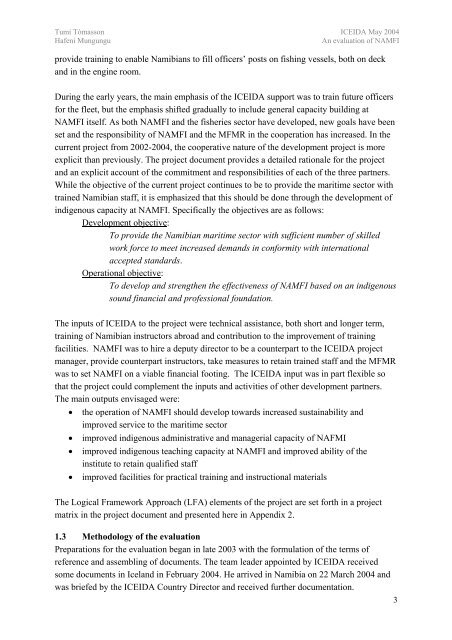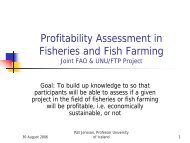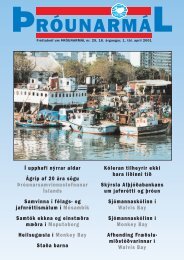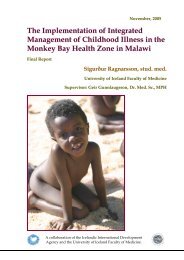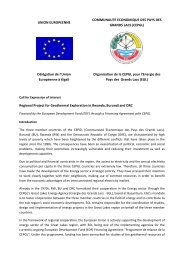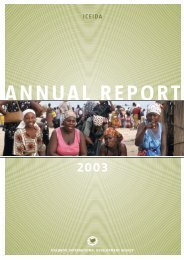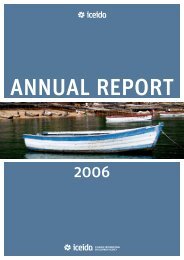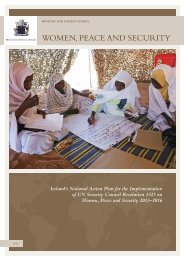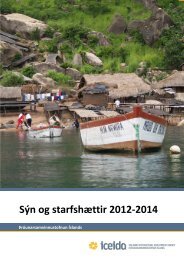An Evaluation of the NAMFI/ICEIDA Cooperation Project 2002 -2004
An Evaluation of the NAMFI/ICEIDA Cooperation Project 2002 -2004
An Evaluation of the NAMFI/ICEIDA Cooperation Project 2002 -2004
Create successful ePaper yourself
Turn your PDF publications into a flip-book with our unique Google optimized e-Paper software.
Tumi Tómasson <strong>ICEIDA</strong> May <strong>2004</strong><br />
Hafeni Mungungu<br />
<strong>An</strong> evaluation <strong>of</strong> <strong>NAMFI</strong><br />
provide training to enable Namibians to fill <strong>of</strong>ficers’ posts on fishing vessels, both on deck<br />
and in <strong>the</strong> engine room.<br />
During <strong>the</strong> early years, <strong>the</strong> main emphasis <strong>of</strong> <strong>the</strong> <strong>ICEIDA</strong> support was to train future <strong>of</strong>ficers<br />
for <strong>the</strong> fleet, but <strong>the</strong> emphasis shifted gradually to include general capacity building at<br />
<strong>NAMFI</strong> itself. As both <strong>NAMFI</strong> and <strong>the</strong> fisheries sector have developed, new goals have been<br />
set and <strong>the</strong> responsibility <strong>of</strong> <strong>NAMFI</strong> and <strong>the</strong> MFMR in <strong>the</strong> cooperation has increased. In <strong>the</strong><br />
current project from <strong>2002</strong>-<strong>2004</strong>, <strong>the</strong> cooperative nature <strong>of</strong> <strong>the</strong> development project is more<br />
explicit than previously. The project document provides a detailed rationale for <strong>the</strong> project<br />
and an explicit account <strong>of</strong> <strong>the</strong> commitment and responsibilities <strong>of</strong> each <strong>of</strong> <strong>the</strong> three partners.<br />
While <strong>the</strong> objective <strong>of</strong> <strong>the</strong> current project continues to be to provide <strong>the</strong> maritime sector with<br />
trained Namibian staff, it is emphasized that this should be done through <strong>the</strong> development <strong>of</strong><br />
indigenous capacity at <strong>NAMFI</strong>. Specifically <strong>the</strong> objectives are as follows:<br />
Development objective:<br />
To provide <strong>the</strong> Namibian maritime sector with sufficient number <strong>of</strong> skilled<br />
work force to meet increased demands in conformity with international<br />
accepted standards.<br />
Operational objective:<br />
To develop and streng<strong>the</strong>n <strong>the</strong> effectiveness <strong>of</strong> <strong>NAMFI</strong> based on an indigenous<br />
sound financial and pr<strong>of</strong>essional foundation.<br />
The inputs <strong>of</strong> <strong>ICEIDA</strong> to <strong>the</strong> project were technical assistance, both short and longer term,<br />
training <strong>of</strong> Namibian instructors abroad and contribution to <strong>the</strong> improvement <strong>of</strong> training<br />
facilities. <strong>NAMFI</strong> was to hire a deputy director to be a counterpart to <strong>the</strong> <strong>ICEIDA</strong> project<br />
manager, provide counterpart instructors, take measures to retain trained staff and <strong>the</strong> MFMR<br />
was to set <strong>NAMFI</strong> on a viable financial footing. The <strong>ICEIDA</strong> input was in part flexible so<br />
that <strong>the</strong> project could complement <strong>the</strong> inputs and activities <strong>of</strong> o<strong>the</strong>r development partners.<br />
The main outputs envisaged were:<br />
• <strong>the</strong> operation <strong>of</strong> <strong>NAMFI</strong> should develop towards increased sustainability and<br />
improved service to <strong>the</strong> maritime sector<br />
• improved indigenous administrative and managerial capacity <strong>of</strong> NAFMI<br />
• improved indigenous teaching capacity at <strong>NAMFI</strong> and improved ability <strong>of</strong> <strong>the</strong><br />
institute to retain qualified staff<br />
• improved facilities for practical training and instructional materials<br />
The Logical Framework Approach (LFA) elements <strong>of</strong> <strong>the</strong> project are set forth in a project<br />
matrix in <strong>the</strong> project document and presented here in Appendix 2.<br />
1.3 Methodology <strong>of</strong> <strong>the</strong> evaluation<br />
Preparations for <strong>the</strong> evaluation began in late 2003 with <strong>the</strong> formulation <strong>of</strong> <strong>the</strong> terms <strong>of</strong><br />
reference and assembling <strong>of</strong> documents. The team leader appointed by <strong>ICEIDA</strong> received<br />
some documents in Iceland in February <strong>2004</strong>. He arrived in Namibia on 22 March <strong>2004</strong> and<br />
was briefed by <strong>the</strong> <strong>ICEIDA</strong> Country Director and received fur<strong>the</strong>r documentation.<br />
3


